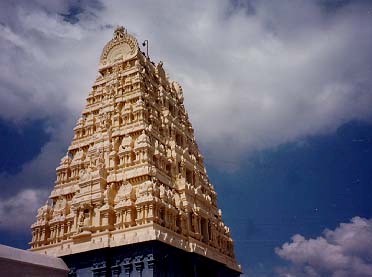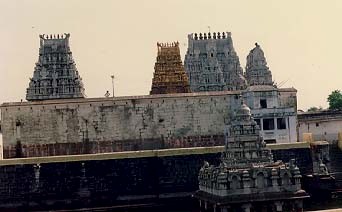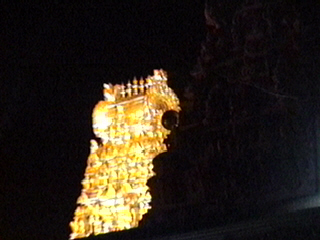The town of Kanchi was the capital of
the ancient Pallavas. The Kailasanathar temple here is
one of the grand Pallava monuments. The Kamakshi Amman temple at
Kanchipuram is an ancient one and is associated with Aadi Sankaracharya of the 1st
millennium CE. The Tamil saying Kanchi Kamakshi, Madurai
Meenakshi and Kaasi Visalakshi
illustrates the importance of the Shakthi shrine that it is.

Ekambreswarar temple,
the Kamakshiamman Temple and the Kumara Kottam temple
and the Ulagalanda Perumaal Temple are the
primary shrines in Periya Kanchipuram. The first three mentioned above are located in a
manner as to suggest the Somaskanda manifestation of Shiva, Uma and Skanda
in the town of Kanchi. There are no shrines to Ambal, in any of the shrines to Shiva in
Kanchi. Kamakshi is considered to be wholly present in Kanchipuram, as the only Ambal
shrine.

Legend has it that Kamakshi offered
worship to a Shivalingam made out of sand, under a mango tree and gained Shiva's hand in
marriage. (See also Ekambreswarar temple and Nilattingal Tundam).
The temple covers an area of about 5 acres, and the sanctum is crowned
with a gold plated vimanam. Kamakshi is enshrined in a seated posture in the sanctum - and
is referred to as the Parabhrama Swarupini, seated with Bhrama Vishnu
Rudra Eswara and Sadasiva. A Sri Chakram has been installed in front of the image and
worship is offered to it.
It is believed that Kamakshi was originally a Ugra Swaroopini, and that
Aadi Sankaracharya, upon establishing the Sri Chakra, personified her as the Shanta
Swaroopini (see also Akhilandeswari at Tiruvanaikkaval).
It is believed that during the days of Adi Sankara, the presence of the Ugra Swaroopini
was felt outside the temple precincts, and that Sankaracharya had requested her not to
leave the temple complex. Symbolic of this, the festival image of Kamakshi, takes leave
from Sankaracharya, at his shrine in the inner prakaram, each time she is taken out in
procession.

The layout of the temple is rather complicated. The outer prakaram houses the temple tank,
and several mandapams such as the 100 pillared hall, the dwajaarohana mandapam etc.
Imposing views of the golden vimanam can be had from the outer prakaram,
which is pierced with four entrances on all four sides. Images to Vishnu
(Ninraan, Irundaan, Kidandaan) are seen near the temple tank.
One enters the four pillared hall then the inner prakaram, and climbs a series of steps,
and reaches the sanctum. Immediately surrounding the sanctum are small shrines to
Ardhanareeswarar, Soundaryalakshmi, Kallar (who
has been mentioned in the hymns of Tirumangaialwar) and Varaahi. In this prakaram are
shrines to Bangaru Kamakshi, Maha Saraswathi and Aadi Sankaracharya.
Kanchipuram is the seat of the Kanchi Kamakoti Peetham established by
Adi Sankaracharya. It is believed that Sankaracharya attained samadhi at
Kanchipuram, although another school of thought holds that Kedarnath
in the Himalayas is the site of his samadhi.
Festivals: Four worship services are offered each day. The jewels
adorning the image of the deity are of great beauty. The annual festival is celebrated in
the month of Maasi. The silver chariot festival falls on the 7th day. Other festivals
include Navaratri, Aadi and Aippasi Pooram, Sankara Jayanthi and Vasanta Utsavam in
Vaikasi.
